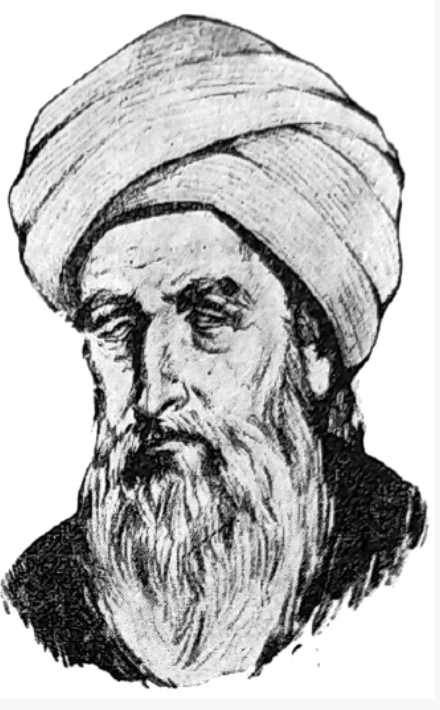The Epistle of Forgiveness: The Arab Divine Comedy

By Luke McMahan/ Arab America Contributing Writer
In the eleventh century, controversial Syrian thinker and poet Al-Ma’ari responded to a rival’s intellectual challenge with an expansive epic text, The Epistle of Forgiveness (رسالة الغفران), which would be compared to Dante’s Divine Comedy, which came three hundred years later (although Dante drew no influence from it).
Al-Ma’ari
Abu Al-’Ala Al-Ma’ari (أبو العلاء المعري), referred to simply as Al-Ma’ari after his home village, was born in 923 during the Abbasid period in northwestern Syria. Having contracted smallpox as a toddler, his vision became severely impaired most of his life, and was likely blind in middle age.
He came from a successful family of religiously liberal poets and judges, perhaps due in part to their Sunni community including many Christians and Shias. He went on to study in Aleppo, Baghdad, Tripoli, and Antioch, absorbing all of the literature he could before total blindness set in; and finally returned to Syria. There he continued to write and teach, with his home attracting students and thinkers from around the world until he died in 1057.
Al-Ma’ari was by no means a classical Islamic thinker. While he remained a Muslim all his life, he was remarkably rationalist for his age. He strongly critiqued religious superstitions and dogmatism (present in any religion of the time, not only Islam) throughout his life. He also harbored doubts about several Islamic tenets, such as divine revelation and bodily resurrection, which earned him criticism from academics and religious figures. Al-Ma’ari identified foremost as a philosopher guided by reason, especially when compared to tradition, religious or otherwise.
He frequently espoused strongly pessimistic and even antinatalist (against the bearing of more children) views. Furthermore, he lived an ascetic life, never sold his poems, renounced violence, and practiced vegetarianism. These aspects taken together present the portrait of a unique philosopher for his time, akin in many ways to modernist thinkers centuries later. Controversy over the figure continues to this day, as members of the Al-Qaeda affiliate the Al-Nusra Front beheaded a statue of Al-Ma’ari in 2013 for unknown reasons.
The Epistle of Forgiveness
Around the year 1033, scholar Ibn Al-Qarih sent an epistle to Al-Ma’ari. In it, he brandished his orthodoxy and learnedness, called a friend of Al-Ma’ari and a former patron of Al-Qarih a madman, and claimed that many famous Arab poets, including some who lived before the introduction of Islam, were heretics. This acted as an implicit challenge to his rival’s intellect and piety, taken in the context of previous accusations of heresy for Al-Ma’ari. In response, Al-Ma’ari wrote The Epistle of Forgiveness, not only thoroughly answering attacks to his artistic and intellectual capabilities but also providing fascinating societal and philosophical commentary.
The book begins with a lengthy preamble, which thanks and directly responds to Al-Qarih’s letter, albeit filled with ironic and sarcastic praise. Then, volume one, the most famous section of the Epistle, imagines Al-Qarih (called the Sheikh) attempting to enter Paradise on the Day of Judgement after having lost a document of the sins he seeks repentance for.
He finally gains admittance, and upon reaching Heaven seeks out famous poets to discuss writing and grammar with. Several of these poets wrote somewhat irreligious works; and some died before Muhammad’s time, which introduces questions of why they were forgiven and present in Paradise. These poets often answer the Sheikh’s passionate queries of poetry with disinterest, having forgotten what they wrote on Earth or lost interest in such pedantic matters.
Throughout these sections, the images of Heaven build upon popular conceptions of the time: a place filled with sensual pleasures of drinking, feasting, beautiful women emerging from plants and animals, and animals happy despite being forever feasted upon. The Sheikh meets demons granted forgiveness, converses with the Devil and others condemned to Hell, and interacts with beings who have gained superpowers in Paradise.
The second volume returns to Al-Qarih’s letter specifically, showing his own extraordinary intellectual capacities and eloquence. For example, he composed thousand-word sections on a few lines of Al-Qarih’s, retaliating in full to the other’s challenges while simultaneously mocking the latter’s character and letter.
The book is simultaneously ironically critical and filled with genuine intellectual interest, written in response to a scholar and grammarian by another scholar and grammarian. As Matthew Reynolds puts it in the foreword to a translation of the Epistle, “Abū l-ʿAlāʾ makes fun of Ibn al-Qāriḥ but he also recognizes that he and Ibn al-Qāriḥ share many of the same interests and impulses”(xvi).
The Epistle seems to be prompting Al-Qarih to repent for his own self-obsession and indulgence, proud condemnation of past Arab poets, and disrespect of the aforementioned friend of Al-Ma’ari. The character Al-Qarih in the Epistle only gains divine forgiveness and enters Heaven after much struggle, and there he shows his obsession with poetry to the point of discussing solely academic subjects instead of significant questions after meeting figures like Adam and the Devil.
In other words, Al-Ma’ari says that his rival’s letter presents no real repentance and only further brands him as a self-righteous pedant. His commentary also extends beyond Al-Qarih, as his fantastical view of Paradise seems to mock obsessively sensual popular beliefs of Heaven.
But remarkably, his satirical jesting doubles as a passionate discussion of various poetic and grammatical concepts, as he devoted his life to such subjects. This prompts debate about art and writing beyond the ironic and critical purposes of the piece.
Altogether, Al-Ma’ari’s Epistle is a truly unique Arab literary work. Its endless artistic and intellectual value serves as a response to an academic challenge, affirmation of his own abilities, ironic discussion of popular beliefs, and genuine discourse on language and poetry. While often compared with The Divine Comedy for its similar setting, it is a wonderful and singular work on its own merit.
Sources:
al-Maʿarrī, Abū l-ʿAlāʾ, et al. “Introduction.” The Epistle of Forgiveness: Volumes One and Two, NYU Press, 2016, pp. xxiii–xlii. JSTOR, http://www.jstor.org/stable/j.ctt1803zrj.6. Accessed 16 July 2024.
REYNOLDS, MATTHEW, et al. “Foreword.” The Epistle of Forgiveness: Volumes One and Two, NYU Press, 2016, pp. xv–xx. JSTOR, http://www.jstor.org/stable/j.ctt1803zrj.3. Accessed 16 July 2024.
Stetkevych, Suzanne Pinckney. “The Snake in the Tree in Abu Al-ʿAlaʾ al-Maʿarri’s ‘Epistle of Forgiveness’: Critical Essay and Translation.” Journal of Arabic Literature, vol. 45, no. 1, 2014, pp. 1–80. JSTOR, http://www.jstor.org/stable/43304767. Accessed 16 July 2024.
https://en.wikipedia.org/wiki/Al-Ma%27ari
https://poets.org/poet/al-maari
Al Ma’arri: visionary free thinker
Check out our Blog here!









